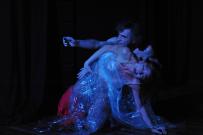Supporta Gothic Network
London Camden Fringe. Beings as a pre-social butoh
When writing about Beings, all the normal terms go out the window. It doesn't make sense to talk about characters, narratives or topics, stage presence, technical skill or direction. It's categorised as 'dance', but this term also falls short. Indeed, the two 'beings' in the 'dance' can hardly be described as 'people'.
Beings is a butoh dance, and is framed by the story of The Cenci, a dramatic play by Percy Bysshe Shelley based on a horrific true story of an Italian family. It also draws on the thought and practice of Antonin Artaud and his revolutionary approach to the theatre. But, again, all this only serves as a frame: each performance is different, unwritten, with a decentralisation of agency so that mind no longer informs body, body no longer governs space. All elements flow into a kind of unified, non-hierarchical organism. This is also reflected in the use of sound, also unwritten, with the cello no longer a cello but simply a sound-generator responding to moments.
This kind of performance rejects the doctrine of representation and imitation in performance, instead becoming a form of life itself, almost pre-social. The title 'Beings' no doubt alludes to the difficult problem of engaging with reality or the human condition before it is mediated through language or culture. As a result, the performance is thematically allusive, allowing the audience to engage with the energy of the piece. Even so, the tragedy of The Cenci communicates a certain amount of despair, fragility, and pain, and the physicality of the beings heightens these sensations into a kind of pure form that reveals the inadequacy of language and representation.
It all leaves the audience in a somewhat precarious position, sitting before this gruelling and gradual display of mental and bodily torture, the rolling eyes and taut limbs. This is no accident, as the audience's voyeuristic engagement with this non-performance is intended to produce a kind of mirrored internal reaction. Ultimately, the dancers and the audience become equally disengaged from the facade of reality as we usually experience it.
You soon forget that these things are people just like us, and at the end of the dance we were invited by the cellist to go over and look at the two beings, who by now have fallen off the back of the stage and frozen. This was like peering into a cage in which the animals were doing something strange, and wondering if they were OK.
It's all pretty heavy stuff, but the collective do it with such uncompromising force that it's hard to be cynical – you just get wrapped up in it. After the show, we sat in the theatre, and then the bar, then outside, talking to the three practitioners about the world of butoh – the thought, history and technicalities that go into the dance.
This is not your everyday show, and it's very rare to come across this kind of performance. So if you can then go and see some butoh, not only to witness this unusual experience but to see how it affects you.





